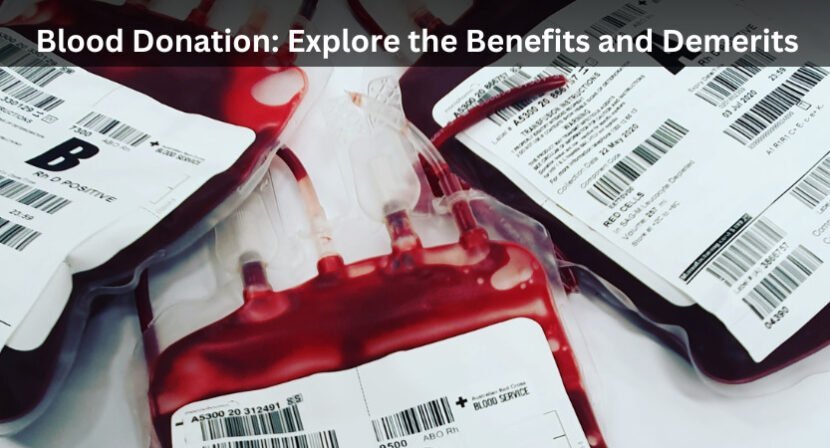Introduction:
Blood donation is a selfless act that involves voluntarily providing one’s blood to help save the lives of others. It plays a crucial role in healthcare systems worldwide, providing a constant blood supply for transfusions and medical treatments. In this article, we will delve into the benefits and demerits of blood donation, exploring its impact on both donors and recipients.
Blood Types:
Blood types are a crucial aspect of blood donation and transfusion. Understanding the different blood types is essential to ensure compatibility and minimize the risk of adverse reactions during transfusions. The most common blood type classification system categorizes blood into four types: A, B, AB, and O. Let’s explore each blood type in detail:
- Blood Type A: Blood type A individuals have red blood cells with A antigens on their surface. They also have antibodies against type B blood. This means that people with blood type A can donate blood to individuals with blood types A and AB. However, they can receive blood from individuals with blood types A and O.
- Blood Type B: Blood type B individuals have red blood cells with B antigens on their surface and antibodies against type A blood. Consequently, individuals with blood type B can donate blood to those with blood types B and AB. They can receive blood from individuals with blood types B and O.
- Blood Type AB: Individuals with both A and B antigens have red blood cells on their surface. However, they have no antibodies against type A or B blood. This unique characteristic allows individuals with blood type AB to donate blood to those with blood type AB but receive blood from any blood type (A, B, AB, or O). Blood type AB is often referred to as the universal recipient.
- Blood Type O: Blood type O individuals have neither A nor B antigens on their red blood cells. However, they have antibodies against both type A and B blood. Consequently, individuals with blood type O can donate blood to individuals with any blood type (A, B, AB, or O). They are often called universal donors. However, individuals with blood type O can only receive blood from donors with blood type O.
Rh Factor:
Besides the ABO blood types, the Rh factor is another important factor in blood compatibility. The Rh factor refers to the presence or absence of the Rh antigen in the red blood cells. If the Rh antigen is present, the blood type is Rh-positive (Rh+); if it is absent, it is Rh-negative (Rh-). Rh-positive blood can generally be given to Rh-positive and Rh-negative individuals. In contrast, Rh-negative blood should only be given to Rh-negative recipients.
Blood typing is essential before transfusions to ensure donor and recipient compatibility. The knowledge of blood types allows healthcare professionals to select the appropriate blood products for patients, minimizing the risk of adverse reactions and promoting successful transfusions.
Blood Composition:
Blood is a remarkable fluid that plays a crucial role in the functioning of our bodies. It comprises several components, each with unique functions and characteristics. Let’s explore the composition of blood in more detail:
- Red Blood Cells (Erythrocytes): Most of the cells in the blood are red blood cells. They are in charge of getting oxygen from the lungs to every part of the body and returning carbon dioxide to the lungs so it can be breathed out. The red colour of blood comes from a protein called haemoglobin that binds to oxygen. This is what makes blood red.
- White Blood Cells (Leukocytes): White blood cells are an essential part of the immune system and play a vital role in defending the body against infections and diseases. They help identify and destroy harmful bacteria, viruses, and other pathogens. White blood cells are classified into different types, such as neutrophils, lymphocytes, monocytes, eosinophils, and basophils, each with specialized functions.
- Platelets (Thrombocytes): Platelets are small cell fragments involved in the blood clotting process (hemostasis). When there is an injury or damage to blood vessels, platelets gather at the site to form a clot, preventing excessive bleeding. This clotting mechanism is vital for wound healing and preventing excessive blood loss.
- Plasma: Plasma is the liquid component of blood, making up approximately 55% of its total volume. It is a yellowish fluid composed mainly of water, electrolytes, proteins, hormones, waste products, and other substances. Plasma helps maintain the balance of fluids in the body, transports nutrients, hormones, and waste materials, and plays a crucial role in regulating body temperature.
Blood Donation Types:
Blood is a remarkable fluid that plays an essential role in the functioning of our bodies. It comprises several components, each with unique functions and characteristics. Let’s explore the composition of blood in more detail:
- Red Blood Cells (Erythrocytes): Red blood cells are the most abundant cells in the blood. They are in charge of getting oxygen from the lungs to every part of the body and returning carbon dioxide to the lungs so it can be breathed out. The red colour of blood comes from a protein called haemoglobin that binds to oxygen. This is what makes blood red.
- White Blood Cells (Leukocytes): White blood cells are essential to the immune system and help protect the body from diseases and infections. They help identify and destroy harmful bacteria, viruses, and other pathogens. White blood cells are classified into different types, such as neutrophils, lymphocytes, monocytes, eosinophils, and basophils, each with specialized functions.
- Platelets (Thrombocytes): Platelets are small cell fragments involved in the blood clotting process (hemostasis). When there is an injury or damage to blood vessels, platelets gather at the site to form a clot, preventing excessive bleeding. This clotting mechanism is vital for wound healing and preventing excessive blood loss.
- Plasma: Plasma is the liquid component of blood, making up approximately 55% of its total volume. It is a yellowish fluid composed mainly of water, electrolytes, proteins, hormones, waste products, and other substances. Plasma helps maintain the balance of fluids in the body, transports nutrients, hormones, and waste materials, and plays a crucial role in regulating body temperature.
Benefits of Blood Donation:
Blood donation is a selfless act that brings numerous benefits to the recipients and the donors themselves. Let’s explore the various benefits of blood donation in more detail:
- Saving Lives: Blood donation’s primary and most significant benefit is saving lives. Donated blood is used in emergencies, surgeries, and medical treatments for patients with life-threatening conditions. By donating blood, you have the power to make a direct and positive impact on someone’s life.
- Improved Cardiovascular Health: Regular blood donation has been linked to improved cardiovascular health. It helps maintain healthy blood viscosity, reducing the risk of heart reduces such as heart attacks and strokes. By donating blood, you lower the iron levels in your body, reducing the risk of iron overload, which is associated with cardiovascular problems.
- Stimulation of Blood Cell Production: When you donate blood, your body replenishes the donated blood by producing new blood cells. This process stimulates the bone marrow to increase its red blood cell production. As a result, regular blood donors may experience enhanced blood cell production, leading to healthier blood circulation and improved overall well-being.
- Screening and Early Detection: Blood donation involves a thorough screening process to ensure the safety of the donated blood. Donors undergo medical history checks, physical examinations, and tests for infectious diseases. This screening process can sometimes detect underlying health conditions or infections the donor may not have known. As a result, blood donation can serve as an opportunity for early detection and intervention.
- Reduced Risk of Cancer: Some studies suggest that regular blood donation may be associated with a low risk of certain types of cancers, including liver, lung, colon, and throat. Although the exact reasons for this association are not fully understood, it is believed that blood donation helps remove excess iron from the body, which could potentially protect against cancer development.
- Psychological and Emotional Well-being: Donating blood can have positive psychological and emotional effects on the donors. It gives them a sense of completeness, joy, and purpose by knowing they are making a tangible difference in the lives of others. Giving can also evoke joy, satisfaction, and a sense of community involvement.
- Benefit to Skin: Blood donation can also indirectly benefit the skin. Improved blood circulation from regular blood donation ensures the skin receives adequate oxygen and nutrients. This can contribute to healthier, radiant, and clearer skin. Additionally, removing toxins from the body through blood donation can help purify the blood, potentially improving skin health.
By donating blood, you contribute to saving lives and experience potential health benefits. It is important to note that individual benefits may vary, and it is always recommended to consult healthcare professionals for personalized advice.
Demerits of Blood Donation:
While blood donation is a noble act, it does have some demerits:
- Temporary Fatigue: Some donors may experience temporary fatigue or weakness after donating blood. This is generally short-lived and can be alleviated by rest and proper hydration.
- Iron Deficiency: Regular blood donation may decrease iron stores in the body, potentially causing iron deficiency. However, this can be managed by following a balanced diet or taking iron supplements if a healthcare professional advises.
How much blood can we donate?
The amount of blood that can be donated depends on the donor’s health, weight, and local regulations. Typically, donors can donate about 1 unit of whole blood, roughly 470 ml.
Scarcity of Blood in Blood Banks:
Blood scarcity in blood banks is a significant challenge healthcare systems face globally. The demand for blood often surpasses the supply, leading to shortages. This highlights the importance of regular blood donation to maintain an adequate blood supply for emergencies and medical treatments.
Moral Positive Feelings of Blood Donation:
Apart from the physical benefits, blood donation can provide a sense of moral fulfilment and positive emotions. Donors often experience a sense of satisfaction, knowing that their kindness has potentially saved lives and made a significant difference in the community.
Conclusion:
Blood donation is an act of altruism that holds immense importance in healthcare systems worldwide. The benefits of blood donation, such as saving lives, improving cardiovascular health, and benefiting the skin, outweigh the temporary demerits. Individuals must understand the significance of regular blood donation, as it helps maintain a sufficient blood supply and contributes to the well-being of society as a whole. By donating blood, one becomes a lifesaver, embodying compassion and selflessness.


